

MOA Scope Mount
MOA scope mount, these are scope mounts that basically help us from running out of elevation adjustment at longer ranges. Gravity being the culprit here.
Table of Contents
MOA scope mounts are scope mounts that help us from running out of elevation adjustment at longer ranges. Gravity is the culprit here. (Imagine if Newton had not invented gravity, we would be so much better off. 😉)
These mounts are specifically designed to help you improve the accuracy of your shots at greater distances than with a conventional mount. They accomplish this by being tapered or elevated at the rear. This tapered design allows you to make adjustments to your scope, which “run out” of elevation adjustment at a certain range. By using an MOA scope mount, you can “dial in” your shot to ensure that it hits its target, even at ranges where gravity and other factors can affect the trajectory of your bullet. So if you’re a long-range shooter looking to reach those long-range targets, an MOA scope mount is worth considering!
MOA Scope Mount and how it works
Note: The diagrams in this article are not to scale and are only for representation.
A bore aligned rifle and scope
In a perfect environment, you line up the bore with the centre of a target 20 meters away. You can do this by a laser device mounted in the rifle breach or just do it the old-fashioned way and take the bolt out a take a look down the bore yourself with the mark one eyeball.
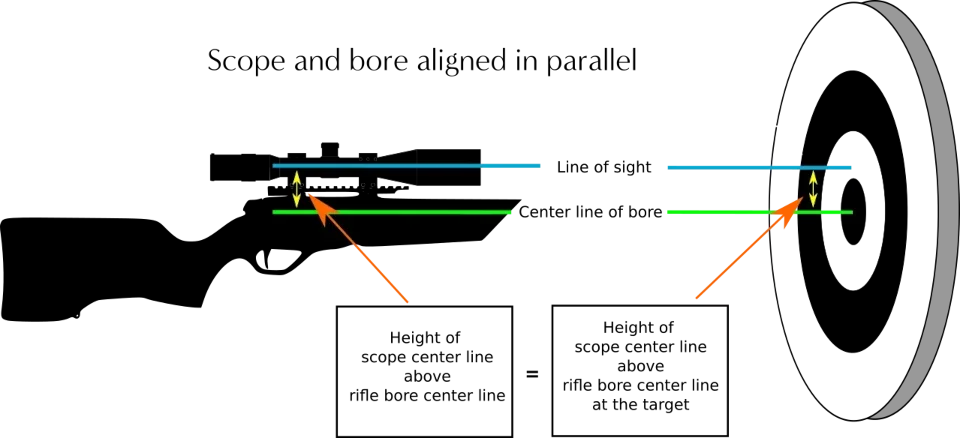

Take the diagram above, it depicts a rifle that is bore aligned. That is, when you look down the rifle bore, it is centred on the target. The scope, if truly parallel, would centre on the target plus the distance that the scope is mounted above the rifle bore.
More on How to Bore Sight a Rifle here:
Now, if it were not for gravity, all we would have to do is adjust the elevation of the scope to centre on the target and bingo, we are done.
A bore sighted scope
First, we have to raise (tilt up) the rear of the scope so what we look at through the scope corresponds with the alignment of the rifle bore.
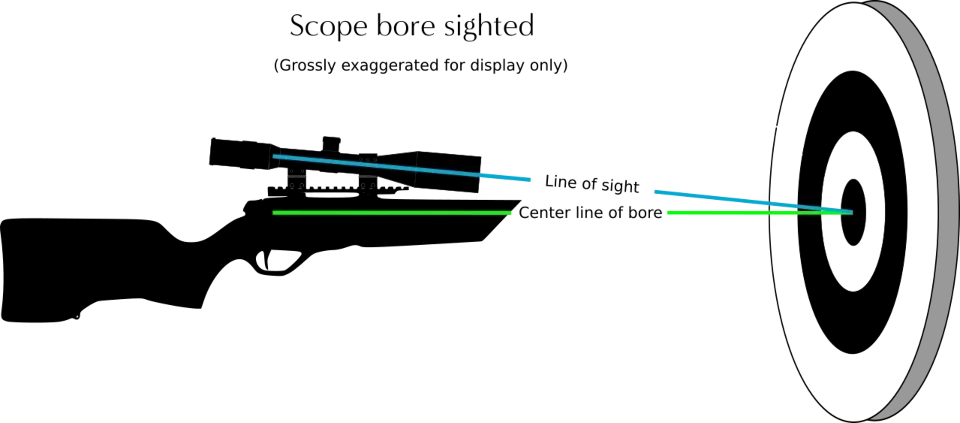

Then we have to compensate for gravity.
A zeroed scope
Effectively, the line of sight remains in the same position but with the rear of the scopes adjustment raised.
The result is the barrel elevates the trajectory of the projectile so the “fall of shot” hits the desired target.

The amount of adjustment is commonly measured as an angle. In this case Minutes of Angle or MOA. (This can also be measured in MILS or MRAD).
A scopes elevation range in MOA
There is typically a range of adjustment for the scope (MOA adjustment range) that is dictated by a number of factors.
These factors are covered in our article Erector Tube Assembly here:
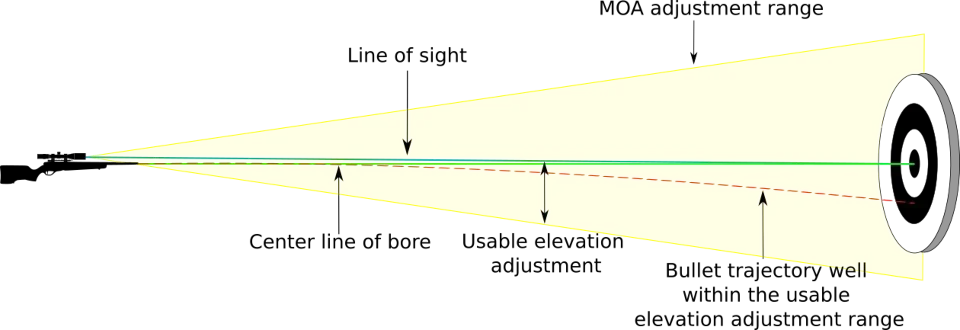
Most scopes have an elevation range of 50 to 120 MOA. Only half of that is useful as it adjusts both up and down. Essentially leaving you 25 to 60 of upward elevation MOA to play with.
Scope centered at 0 (zero) MOA
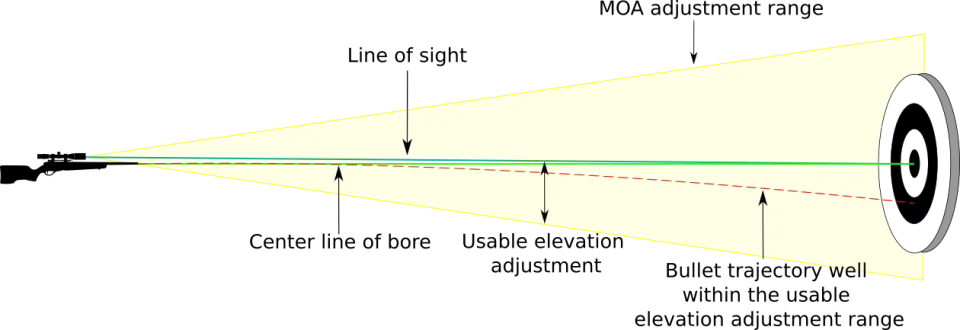
The scope is now centred at 0 (zero) MOA with plenty of elevation adjustment available to compensate for bullet drop.
Scope with elevation adjusted

The scope with elevation adjusted for bullet drop.
Note: The amount of usable elevation adjustment remaining is decreasing. This decrease will accelerate with further increases in range.
Scope with no usable elevation adjustment remaining
So, the internal mechanism of the scope has run out of adjustment for those longer-range targets. This is when external assistance is required. This help comes in the form of a scope mount that has the rear of the mount elevated which compensates for the lack of internal adjustment at longer ranges. These tapered mounts are typically measured as an angle and common use is minute of angle (MOA).
Note: (MRAD and MIL can also be used)
MOA mounts are usually around +20 MOA but can vary depending on the use case.
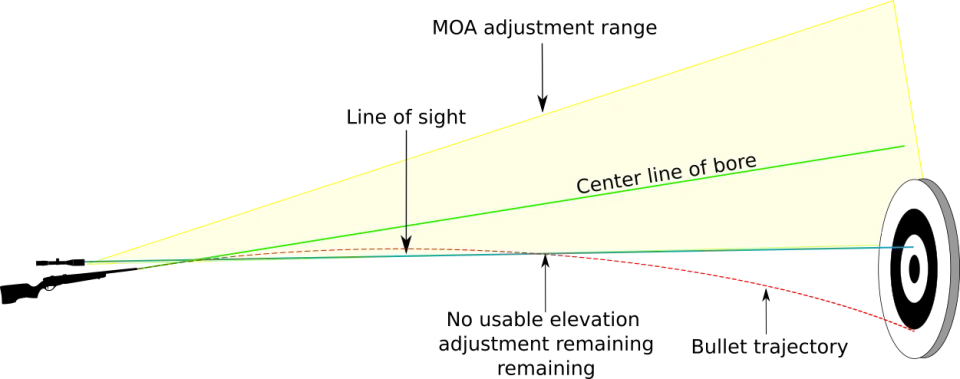
Example of +20 MOA Picatinny Rail Mount

Rifle with +20 MOA Picatinny Rail Mount


Scope with MOA rail fitted
The MOA rail has the rear of the mount elevated which gives the scope enough room to allow the internal adjustment to be effective at longer ranges.
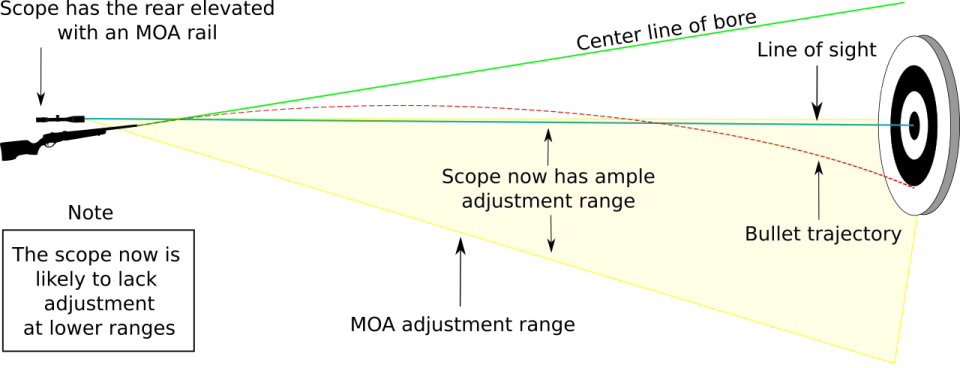
+MOA considerations
A scope fitted with a +MOA mount is highly likely to run out of adjustment range at smaller distances.
Video - Vortex discusses MOA Bases
FAQ (Frequently Asked Questions)
What does a 20 MOA rail mean?
A 20 MOA (Minute of Angle) rail refers to the angle of elevation built into the rail of a firearm. This angle allows for the user to adjust the point of impact of their shots by 20 MOA, which can be useful for long-range shooting. This means that for every 100 yards the bullet travels, it will be 20 inches higher at the point of impact. MOA is a standard unit of measurement for adjusting the point of aim of a firearm.
What is MOA on a rail?
MOA (Minute of Angle) on a rail refers to the angle of elevation built into the rail of a firearm. This angle allows the user to adjust the point of impact of their shots by a certain number of MOA, usually from 0 to 60 MOA, which can be useful for long-range shooting. MOA is a standard unit of measurement for adjusting the point of aim of a firearm and it is equal to 1.047 inches at 100 yards. It is used to adjust the point of aim for windage and elevation, for example, if you need to adjust the point of aim 20 MOA up, the rail will be angled in such a way that the point of aim will be 20 MOA higher than the point of impact.
Do you need a 20 MOA rail?
Whether or not you need a 20 MOA rail depends on your specific use case and the type of shooting you will be doing.
A 20 MOA rail can be useful for long-range shooting, as it allows for a greater range of elevation adjustment. This can be especially beneficial for those who will be shooting at targets at distances beyond 600 yards, as the additional adjustment can help to compensate for bullet drop.
However, if you will primarily be shooting at shorter distances, a 20 MOA rail may not be necessary. Additionally, a 20 MOA rail will also increase the weight of the rifle and may not be necessary for those who prefer a more lightweight rifle.
It is important to consider your specific needs and preferences before deciding whether or not to use a 20 MOA rail. It’s also recommendable to consult with a professional or an expert on firearms to get the best advice.
Summary
Overall, MOA scope mounts and their MRAD/MIL counterparts, are a useful (if not essential) bit of gear that can help you improve your long-range shooting skills.